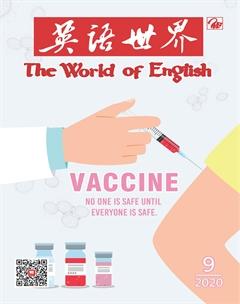人们是如何知道接种疫苗的?
胡婧
Back in the late 1700s, long before people understood the reason behind immunity, farmers and doctors in rural areas of Britain noticed that dairymaids and other people who got a mild disease called cowpox seldom caught its fearsome cousin, smallpox. Was there a connection?
Some decided there was and inserted material from the cowpox into an incision1 they cut on the arm of healthy people, thus somehow protecting them from smallpox. In 1798, a doctor named Edward Jenner published the results of his experiments using this procedure, earning himself fame as the “Father of Smallpox Vaccination.” (In truth, we now know that for hundreds and perhaps thousands of years, Chinese healers had been inducing immunity by pushing smallpox scabs into a persons nose. Some experts now believe that these protective practices—inhaling smallpox virus or pricking the skin—began in Central Asia in the 10th or 11th century.)
Scientists later figured out why Jenner was right that cowpox somehow protected one from smallpox. You see, when people caught cowpox, their bodies made special cells called antibodies. They fought the disease. Thats not all. They lingered in the blood in case the disease ever returned. Because cowpox and smallpox are fairly similar, if a person was later exposed to the more serious disease, antibodies were ready to fight it too.
That knowledge helped scientists develop vaccines. The term vaccination was coined2 from the Latin for cow (vacca). They contain small doses of weakened, dead or modified viruses. Injected into the blood, they trick the immune system into making antibodies. If the body ever encounters those same viruses, even at full strength3, the antibodies make short work of4 them.
The injected polio vaccine, for example, is a killed, intact virus; the oral vaccine is a live, weakened virus. Vaccines for measles, mumps, chickenpox (Varicella), and rubella (German Measles) are live, weakened viruses.
Vaccination prior to exposure to the virus is ideal. But a vaccination given within three days of exposure will completely prevent or significantly modify smallpox in the majority of people and given within the first four to seven days will likely offer some protection or alter the severity of the disease.
18世紀末,早在人们理解免疫的原理之前,英国乡村地区的农民和医生就注意到,挤牛奶的女工和其他患过一种叫牛痘的轻微病症的人很少感染牛痘可怕的表亲——天花。这之间有什么联系吗?
有些人认为有联系,并在健康人的手臂上割开一个小口,植入含有牛痘的物质,以此保护他们免于感染天花。1798年,一位名叫爱德华·詹纳的医生公布了他使用这种方法的实验结果,为自己赢得了“天花疫苗之父”的声誉。(事实上,我们现在知道,中国医士曾通过将天花结痂塞到人的鼻子里来促发免疫力,这种做法持续了数百甚或数千年。如今,一些专家认为,吸入天花病毒或刺破皮肤等防护措施始于10世纪或11世纪的中亚。)
科学家后来发现了詹纳提出的“牛痘以某种方式保护人们免于感染天花”这一说法的正确性,其原理是:当人们感染了牛痘,身体就会产生一种叫做抗体的特殊细胞,它们与疾病作斗争,不仅如此,还存续在血液中,以防疾病复发;因为牛痘和天花比较相近,如果一个人后来接触到更严重的天花,抗体也做好了与之抗争的准备。
这种认识有助于科学家研发疫苗。vaccination(疫苗接种)一词是根据拉丁语vacca(母牛)创造的。疫苗含有少量致弱、灭活或改良的病毒。它们被注射到血液中,诱使免疫系统产生抗体。如果人体再遇到同样的病毒,即使病毒活性十足,抗体也会迅速将其消灭。
例如,注射的脊髓灰质炎疫苗是一种灭活的完整病毒;口服疫苗是一种致弱活病毒。麻疹、流行性腮腺炎、水痘和风疹(又称德国麻疹)的疫苗都是致弱活病毒。
理想的情况是在接触病毒之前接种疫苗。但对大多数人来说,接触后三天内接种疫苗仍将完全预防感染天花或显著改善感染状况;最初的四到七天内接种疫苗可能会起到一定的保护作用,或减轻发病的严重程度。

